Next story: Free Will Astrology
Into the Biennial: Part 3
by Becky Moda & Eric Jackson-Forsberg
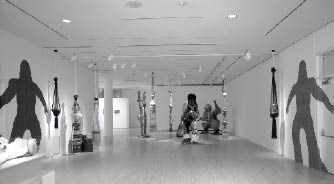
University at Buffalo Art
Gallery, Center for the Arts
While looking at Allyson Mitchell’s Lady Sasquatch installation, it occurred to me that in all representations of Bigfoot I had ever seen, it is always presumed to be male. Why? Is it the hulking size or the copious body hair, both generally regarded as male traits? Mitchell utilizes both size and hair to redefine and recontextualize femaleness with these 10-foot, multi-breasted, genitally engorged monster-women. Covered with fake fur and standing around a campfire in poses inspired by Playboy, these sexy beasts have the power to simultaneously give children nightmares while giving adults the giggles. Mitchell employs the sasquatch myth to emphasize two widely reviled natural physical traits in women: big and hairy. They are in-your-face, lesbian feminist pin-ups: sexual and powerful, pushing against the absurd perceived standards of sexuality and thus crusading for female self-acceptance. The effect is both antagonistic and endearing.
Surrounding the plush giants are pink squirrels, each of them carrying a distinct personality that, I’m told, corresponds with the individual personalities of Mitchell’s former lovers. According to my tally, Mitchell has dated a confused mother; a lazy klutz; a pounce-on-you-while-you-are-doing-something-important type; a level-with-me-now type; a wide-faced, sexless type; an intellectual; a screamer; a fluffy; doe-eyed dame; an actress; a woman who recently came out of the closet; a sexpot; a large and irritable woman; an all-night talker; an attention junkie; and an heiress. They are by turns cute, bewildered and hostile, and provide a strange counterpoint to the giants whose realm they cohabit.
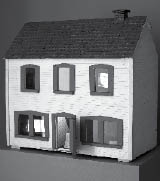
Dorothea Braemer’s stunningly intimate Our House is a true story told from within a dollhouse. The house is situated below eye level, beckoning viewers to get down on their knees to look in. It’s a vulnerable, childish position, making a fitting complement to the content of the installation. This piece deals directly with Braemer’s aging mother, the sale of her Bavarian childhood home and the tumultuous communication between her sisters as they contemplate moving their mother into an assisted living situation. Four films play on tiny monitors in different rooms, each displaying various moments of the family’s history—e.g. a montage of family photographs which are flipped through rapidly—spliced with the current packing-up and clearing-out process the family is engaged in. Paper cut-out masks, simply but realisitically drawn with black marker, playfully obscure the faces of her sisters as they sift through documents. Only her mother reveals her face and smiles at the camera at the end of one of the video loops. An achingly poignant and authentic lament about aging, childhood, change and loss, Our House forces us to contemplate the grim inevitabilities which confronts our own families, past and future. Braemer’s piece sentimentally attempts to ensure that the home will maintain a physical presence in the emotional space created by this delicately structured work.
Richard Price’s work focuses on the importance of community and the revolutionary promise a communtity can portend. Known around Allentown as a superior gardener and brewer, famous for the generosity he shows with his time, his musical instruments, and whatever else at his disposal, his photographs epitomize the idealism of a united community.
For the past decade, Price has documented the men he spends time with each summer at the Blue Heron Farm in Upstate New York. These men call themselves “Radical Faeries” and are a group that dates back to 1979 and celebrates homosexuals as a distinct culture and community, gathering to embrace their inner “sissies,” as well as pagan values of earth, spirit and magic. Translated by Price’s photographs, there is a palpable ease in his subjects, which can be partially attributed to Price, who encourages them to choose the settings and props in his photographs. The simple joy and relief in the subjects‘ faces further underscores the importance of this particular community to these particular men, who are accustomed to being maginalized outcasts of the mainstream culture.

In a side room in UB’s CFA, Diane Schaefer’s photographs are presented to an understated soundtrack of what the artist describes as “found sound.” The photographs likewise display a pastiche of found and fabricated materials set inside scenes. The Buffalo artist collects the bulk of her materials from other people’s trash. Reimagining her found items into unexpected contexts, Schaefer photographs tiny, detailed scenes and then subjects her pictures to aggressive color processing and inkjet printing. The visual result is an intensely vivid inner world. It’s enough to remind one of the hidden puppet realm down the trolley track in Mr. Rogers’ Neighborhood. The narrative stretches clockwise through the room and follows three imaginary textile friends: Rudy Rowdy, Ronnie Dowdy and Nina Rumpus. Really, though, it’s more a mystery than a story, with Schaefer feeding us clues along the way: a glass turkey, a baby shoe, a winged bucket, a ship on train tracks being loaded for departure. Often the photographs are sans character, presumably presenting only the inner space of some unknown feeling. The photos require point-blank scrutiny, which is hard due to the elusive quality of the images and the shadow you cast on the photographs as you view them. There is something eerily delightful about photographs, as if they represented a a secret reality, a place to utterly disappear in. In one particular photograph in the figurine stares at the viewer from below and seems to transcend the image’s two-dimensionality in its ability to enter the viewer’s own inner world. I can still see this image now.
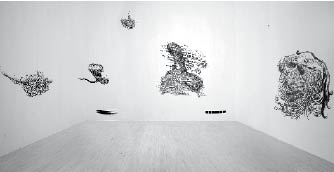
Kate Wilson’s drawings are penned directly onto the walls of the CFA with dark, swirling, diaphanous cyclones of sheer natural force. They exude tendrils of both organic and artificial elements: here a tree, there some space junk. Beautifully shaded and sinewed, they are fraught with ominous portent and psychological power. The effect of these muscular works is heightened by their presentation as graffiti, and the situational quality of the drawing only existing for this show.
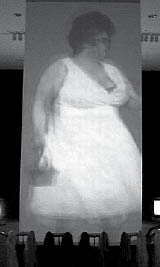
Sarah Paul’s Captain Firepants and the Pretty Ponies beckons us to join a search for someone who doesn’t want to be found. The installation is a sports bar set with the usual flatscreen televisions tuned to Fox News. Buffalo artist Tony Conrad plays a Fox reporter hot on the trail of a missing celebrity in crisis, Captain Firepants, a rock star. Although the music sounds rooted in early new wave, Paul appears to be emulating late-era Elvis with the Firepants persona. However, one only needs to turn on their TV to understand that today’s media is unhealthily obsessed with declining pop stars, virtually salivating over the prospect of Britney or Lindsay’s inevitable overdose. This star, however, appears to be rejecting not only his or her expected career trajectory, but the parameters of society and reality. (How else do you find an overweight dancing diva with a band of plastic pony musicians/romantic partners?) Viewers are encouraged to sit down at the bar and play with the long multi-color ponytails that hang from it; I made several braids while watching. Conrad conducted interviews and attempted to engage viewers to help find the enigmatic star. On another screen, the Captain’s followers groove away endlessly. Will Firepants be found, and relentlessly exploited? Or will she continue to dance in a subculture of her own imagining without interruption?
—becky moda
UB Anderson Gallery

Paul Walde pursues multiple interrogations of the medium of painting, one that has been declared “dead” and resurrected more than once in the past century. The Physical Nature of Immateriality consists of a series of handpainted slides projected on the gallery walls. Rather than project images of larger works, Walde utilizes the slide in reverse, painting directly on the tiny, transparent window. These miniature worlds of luminous color are writ large on three walls as full-fledged, Ab-Ex compositions. They have a wet, slippery quality, as if each work were only a temporary finger painting. Each painting exists only when the light shines through it, its lifespan dictated by the projector’s timer. While technically paintings in every respect, these works subvert the way paintings are created and represented. Other series of Walde’s paintings deconstruct the parameters of the medium through more familiar means. The Xyloexpressionist Paintings are composed of brightly painted wood “brushstrokes” assembled on panels. These exuberant forms seem to have come together in a temporary happenstance of driftwood, allowing the chunks of color to explode and pull against the gravity of their home panels—an uneasy truce between figure and ground. Walde’s Mixed Translations series explores unique textural possibilities. These jagged-edge compositions have a Clyfford Still-like quality, but go well beyond the flat planes of Still’s canvasses. Here, Walde builds-up the surface with heavy black impasto, but also carves into the wood panel, producing remarkable tectonic depth. Each of these series demonstrates Walde’s multivalent search for “…the latent evidence of expression within the medium of paint” (artist’s statement).
To encounter Jason Lee’s installation is to wonder if Nam June Paik has teamed up with LEGO and invaded the gallery. Euthenic Set (Cloudscape) and Euthenic Landscape consist of bright orange, modular units of idealized suburban landscape elements: grass (with the occasional dandelion), white picket fence, clear water and blue sky with small puffs of cloud. These elements are contained in cubic or cylindrical pods, connected by oversized black plugs, cords and sockets, strung along the wall like giant Christmas bulbs or snaked about the floor in small subdivisions of abstracted white fence. The progressive, utopian implications of this modular, plug-in vision of nature are offset by the danger-orange units—an apparent warning of high-voltage. Lee’s work encourages us to contemplate the bounds of what will be accepted as landscape, and to laugh—and shudder—at the prospect of such an instant American dream, coming to a big box store near you.
Brendan Fernandes’ work may come from the same neighborhood as Lee’s, but it explores the boundary between manicured lawn and the verge of tall grass beyond. Natural Refuge appears to be an installation in progress; sealed cardboard boxes are strewn about, with some open to reveal white ceramic fawns—lawn ornaments ready to bring a simulacrum of the wild to suburbia. These shipments are accompanied by potted ornamental grasses that flutter in the manufactured breeze provided by floor fans. The fans lend a deceptive sense of animation to the otherwise artificial scene, but their sound also invokes noise-polluting machines like lawnmowers and airplanes. The transportable, artificial zoo of Natural Refuge inspires dialogue on our insatiable need to experience, package and reproduce “the wild” in our own backyards. Fernandes’ series of digital drawings and installation, Neo-Primitivism, extend this dialogue to include issues of cultural commodification and the equation of the cultural “primitive” with the natural world. In Neo-Primitivism, the ornamental fawns have grown into adult deer decoys (complete with faux painted coats) and have donned plastic African masks. They give the ridiculous impression that they’re trying to blend in by disguising themselves as agents of the appropriated primitive—Picasso’s postmodern lawn ornaments. Similarly, Fernandes’ digital drawings depict various wild animal hybrids, their heads replaced by pseudo-tribal masks or talismans. These drawings have a linear quality akin to aboriginal paintings, but their digital production belies this association. Fernandes’ work presents various opportunities to consider the weird intersections of cultural identity, authenticity and artificiality.
—eric jackson-forsberg
Burchfield-Penney Art Center

Amongst the eclectic array of work at the Burchfield-Penney, the large “paintings” of John E. Drummer stand out—“paintings,” because these wall panels composed of rubber and tar challenge the traditional definitions of the medium. Drummer’s works are almost entirely monochromatic (most in shades of black or dark brown) and rely instead on unique textural effects and odor. The tar Drummer uses adds a surprising, olfactory dimension to experiencing the paintings. Drummer’s abject, found materials are an apt reflection of his Rust Belt studio. The works are created on the floor and take on the grittiness of their surroundings. Drummer’s crazy-quilt constructions are reminiscent of the assemblages of Lee Bontecou, but their black-on-black aesthetic is more attuned to the postmodern gothic. Many of the tar-covered paintings have craters, fissures, hills and valleys like model landscapes, and Drummer’s selective subtraction of material in roughly geometric patterns suggests human intervention—mining perhaps—in this already barren environment. One untitled work introduces white stitching to the black composition to produce clusters of flower-like forms, a darkly beautiful reflection of the large, floral compositions of Japanese screens. These sutured and tarred, Frankenstein monster “canvasses” may be a nightmare for future conservators, but as masterpieces of the industrial aesthetic they have a singular resonance.
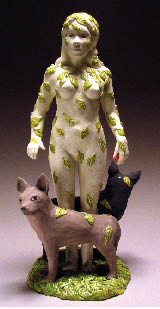
Carrianne Hendrickson’s figural, ceramic pieces are like three-dimensional illustrations of the faerie realm. Inspired by Christina Rossetti’s Goblin Market and by the Martin Brothers’ grotesque ceramic birds, Hendrickson’s creations are at once whimsical and dark. They are infused with the dangerous eroticism found in the edge of adolescence, the risks and rewards of giving in to temptation. Pieces like Piggy Bank for Naughty Thoughts and The Temptation of Laura personify such dangerous moments through medieval tableaux of beatific and diabolical figures. Hendrickson uses the familiar iconography of fruit for temptation, but also employs bloody hearts as symbols of the loss of innocence. Mary’s Got the Postpartum Blues is a grim illustration of the consequences of giving in to sexual desire: A Madonna-like nude with babe in arms stands in a bathtub teeming with demonic, gray infants. Her crown of thorns adds to the iconography of tragedy and sacrifice. In the end, we could literally put any of these pieces on the shelf, their dark narratives mitigated by the mundane functions of piggy bank or teapot.
Jax Deluca’s varied work draws on some of the same power of dichotomy: innocence versus experience, the extroverted versus the introverted, the manic and the depressed. Her two video installations, Reverie d’Ombre: a Dream of Shadow and Solus Quale, stand in sharp contrast to one another—the former a shadowy, black-and-white video triptych with a jarring audio track, and the latter a colorful video painting of fluid, symmetrical forms. Solus Quale uses a swaying female figure mirrored to produce a sort of human Rorschach blot, one that constantly morphs from pose to pose, as if to convey the transience of euphoria. Reverie d’Ombre also employs a figure in the central screen of the triptych installation, but this time it’s an eerie, veiled phantom that rises and falls in a tortured struggle to break free of its shadowy cell. A third installation, Pentamethylenediamene, alludes to decadence through an installation of flesh-stripped bones in a red-lit curio cabinet. With this nod to Damien Hirst’s A Thousand Years, Deluca seems to trump the duality of the other two video installations through a bewildering and harsh reminder of mortality.
The work of Paul Nicholson is a multi-media exploration of childhood and the futility of representing its idyllic past. Perfect World is an image of backyard isolation: a tree swing surrounded by a small precinct of white picket fence. An accompanying detail photograph shows the empty swing through a small hole in the fence. Nicholson’s “perfect world” is a vision of splendid playground isolation, but a melancholy, lifeless and unsustainable one. The microcosm of childhood shown cannot function, and it is only known to us in the outside through the artist’s documentation. See-Saw features another familiar piece of playground equipment—pristine, abandoned and isolated in a larger park-like setting. But this see-saw is utterly obsolete; bent at the fulcrum, it cannot function. The opening of the exhibition also included an ice sculpture, The Frozen Horse, which gradually disintegrated, leaving nothing but a grimy pedestal. This, along with Nicholson’s photographs, may be taken as a metaphor for loss—loss of innocence, idealism and our fleeting comprehension of a perfect world.
—eric jackson-forsberg
|
Issue Navigation> Issue Index > v6n41: Double Vision (10/11/07) > Into the Biennial: Part 3 This Week's Issue • Artvoice Daily • Artvoice TV • Events Calendar • Classifieds |









 Current Issue
Current Issue